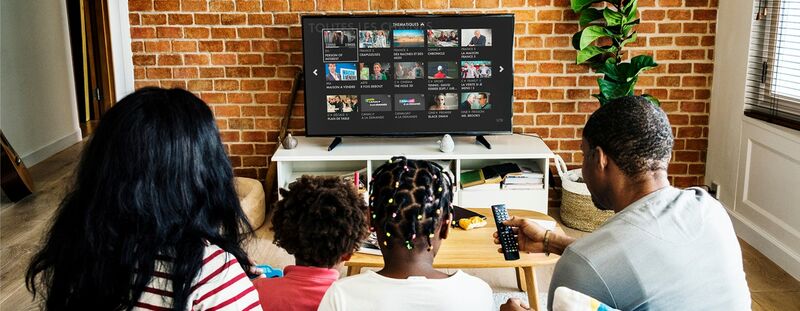- Home
- Results & Studies
- TV content in Africa: local productions and international platforms
TV content in Africa: local productions and international platforms

This backdrop favours the emergence of new content, for which strong demand exists both in television and OTT platforms.
Content: locally produced adaptations and new programmes going from strength to strength.
New programme offerings have arrived on the African continent. Known for its locally-made fictional programming, in particular soap operas, African audio-visual production is growing and evolving, thanks to increased budgets. The continent is also opening up to international formats: in the wake of: Got Talent, Gogglebox and The Voice, Africans can now enjoy local versions of My Kitchen Rules and Dancing with the Stars – all of which are hits with the audience.
And the willingness of African countries to add to their entertainment offering is illustrated by some adaptations in particular. These formats draw inspiration from countries where telenovelas are commonly produced: South Africa and Morocco have made a local version of a Brazilian entertainment format, Coke Studio Maroc, which sees musicians rework traditional musical arrangements.
More serious themes including suspense have emerged in South Africa with the Thriller iNumber Number (Mzansi Magic), inspired by the film of the same name in which a police officer risks his career for his best friend. We could also mention: Tjovitjo (SABC 1), the story of an abandoned child who becomes a villain in adulthood, before seeking redemption and a place in his community through dance. This programme was in the Top 5 in South Africa in 2017 and generated a lot of excitement on social networks.
African channels always heavily schedule family telenovelas, such as The Queen, Ma Grande Famille, etc. However, some new dramedies have also emerged which feature political elements and a more realistic approach. In Morocco, the comedy: Al Moundir Laam (Al Aoula) follows the rebirth of a TV channel on the internet through the vision and the direction of its Managing Director.
In Côte d'Ivoire, Top Radio (RTI 1) deals with the daily life of a new host at a declining radio station which is coveted by two politicians in the run-up to elections. In a novel approach for African TV creation, the producers of this series used a youth talent competition to select the show’s scriptwriters.
OTT platforms: a varied offering undergoing consolidation
In line with global trends, video platforms are rolling out in Africa too. Offering access to Pan-African as well as international content, these platforms have been able to overcome disparities in the development and quality of local infrastructures.
The market currently comprises local players, as well as offerings from the telecoms operators (Black on Cell C or Nuvu on Airtel), and the mighty Netflix and Amazon Prime Video whose global programming has been available on the continent since 2016. So far, the American platforms have provided their African customers with the same offer as the rest of the world.
Other international services that are close behind them – iflix and Showmax – have established ways to enable as many people as possible to access content. First and foremost, they offer the option to download programmes to watch later off-line which gets around the often patchy mobile network; this technology was implemented worldwide by Netflix several years later. They also offer payment options that are included in the telephone / broadband bill from local telecoms companies.
After a prolific start, in the last two years, we have seen some market consolidation. Whilst small platforms have disappeared (Afrostream, Wabona, PanaTV), the major players have become stronger (iflix, ShowMax, iRokoTV), especially through partnerships. Following on from a partnership between Kwesé and Netflix, Kwesé Play emerged in sub-Saharan Africa, offering access to around 100 Roku channels, including Netflix, YouTube, and Red Bull TV. Econet Media – Kwesé’s parent company – and iflix Africa collaborated to launch the mobile app Kwesé-Iflix, which offers content from the catalogues of these two giants. Canal+ and iROKOTV have launched iROKO+, a French language offering. Finally, Trace bought Buni.tv and launched Trace Play beyond Africa’s borders.
At the same time, smaller local platforms are emerging for smartphone – the screen that is best suited to the market and to customs. These platforms include ReelAfrican, Tuluntulu, DEOD, iBAKATV, UN1TY, Afrinolly, and NdaniTV, and they have positioned themselves in niches such as Nollywood movies, dramas, and news and entertainment programmes./p>
The rapidly changing market in Africa demonstrates that, for now, local stakeholders possess the knowledge of the territory, its infrastructure and the customs of its population to offer solid alternatives to the American giants, which do not have the same local strategies for market penetration.
That being said, Netflix and Amazon do not seem to be suffering due to this competition from smaller local platforms which reach a different audience with fewer resources to devote to video entertainment. In fact, a cohabitation of services seems to exist that works in favour of consolidation in the African platform market.
Laure Osmanian Molinero
Source: Eurodata TV Worldwide
des médias
edition
definitions